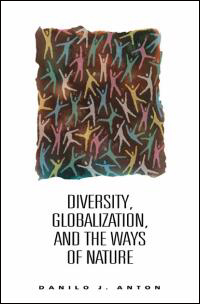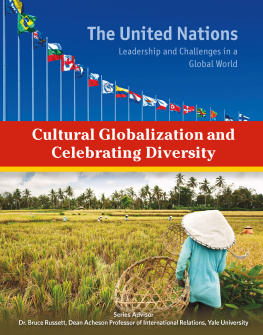Cover

| title | : | Diversity, Globalization, and the Ways of Nature |
| author | : | Anton, Danilo J. |
| publisher | : | International Development Research Centre |
| isbn10 | asin | : | 0889367248 |
| print isbn13 | : | 9780889367241 |
| ebook isbn13 | : | 9781417522132 |
| language | : | English |
| subject | Environmental degradation, Biological diversity conservation, Human ecology--Philosophy. |
| publication date | : | 1995 |
| lcc | : | GE140.A58 1995eb |
| ddc | : | 304.2/8 |
| subject | : | Environmental degradation, Biological diversity conservation, Human ecology--Philosophy. |
Page i
Diversity, Globalization, and the Ways of Nature
Page ii
This page intentionally left blank.
Page iii
Diversity, Globalization, and the Ways of Nature
Danilo J. Anton
INTERNATIONAL DEVELOPMENT RESEARCH CENTRE
Ottawa Cairo Dakar Johannesburg Montevideo Nairobi New Delhi Singapore
Page iv
Published by the International Development Research Centre
PO Box 8500, Ottawa, ON, Canada K1G 3H9
International Development Research Centre 1995
Anton, D.J.
Diversity, globalization, and the ways of nature. Ottawa, ON, IDRC, 1995.xi + 223 p. : ill.
/Environmental degradation/ , /environmental management/ , /biodiversity/ ,/ecological balance/ , /internationalization/ /forests/ , /grasslands/ , /aquaticenvironment/ , /water resources/ , /air quality/ , /energy resources / , /Africa/ ,/Latin America/ , /Caribbean/ , /urban environment/ , /decentralization/ ,bibliography.
UDC: 574 ISBN: 0-88936-724-8
A microfiche edition is available.
All rights reserved. No part of this publication may be reproduced, stored in aretrieval system, or transmitted, in any form or by any means, electronic,mechanical, photocopying, or otherwise, without the prior permission of theInternational Development Research Centre.
IDRC B OOKS endeavours to produce environmentally friendly publications. Allpaper used is recycled as well as recycleable. All inks and coatings are vegetable-based products.
Page v
Contents
Foreword Roberto Bissio | ix |
1. Introduction | |
Globalization and the ways of nature | |
The new globalization processes | |
2. Global Trends and Their Effects on the Environment | |
The information revolution | |
Development of global financial markets | |
Development of more effective transportation networks | |
Movement of people | |
Globalization and the unequal distribution of wealth | |
International migration | |
The development of free markets | |
3. Planet-wide Deterioration | |
Our sister planet | |
The unusual, oxygenated planet | |
The paradox of ozone | |
Oceans canbe degraded too | |
The rivers are becoming muddy | |
Overshooting | |
4. Forests under Attack | |
Deforestation in the 20th century | |
Rain-forest environments | |
Temperate forests | |
Page vi
5. Grasslands. | |
Savannas | |
The temperate grasslands | |
Modifying grassland ecosystems | |
Environmental balance ingrassland ecosystems | |
6. Aquatic Ecosystems | |
Extractive exploitation | |
The future of fish production | |
7. Managing Planetary Thirst | |
Some basic facts | |
Water supply and options | |
The demand side of the issue | |
Water issues throughout the world | |
8. Protecting Air Quality | |
Air and its principal contaminants | |
Processes of contamination in industrial and urban areas | |
Current and future trends | |
9. Clean Energy for Planetary Survival | |
The industrial revolution | |
The use of hydroelectricity | |
The age of petroleum | |
Nuclear power | |
The Clean Options | |
10. Africa in the 21st Century: Sunrise or Sunset? | |
The causes of poverty | |
Historical causes of the current situation | |
Wars are environmentally unfriendly | |
Evolution of environmental management in Africa | |
Old and new development models | |
11. Latin America and the Caribbean: A Historyof Environmental Degradation | |
Indigenous cultures | |
The colonial period | |
Exploitation of natural resources after independence | |
Effects of globalizationon the environment | |
The maquiladora phenomenon | |
Page vii
12. The Urban Environmental Challenge | |
The development of modern cities | |
Large cities in the Third World | |
The megacities of today | |
13. Diversity and Human Survival | |
Documenting diversity | |
Resources for the future | |
Diversity of living systems | |
Causes and effects of the loss of natural diversity | |
Diversity and culture | |
Restoring what is lost | |
Biodiversity and research | |
14. Strategies for the Future | |
Decentralize decision-making | |
People value their environment | |
Problems and responsibilities are global | |
Bibliography | |
Page viii
This page intentionally left blank.
Page ix
Foreword
Today, when someone speaks about natural diversity, the image mostoften evoked is that of the tropical rain forest. On the subject of globalization, the first image might be the logo of CNN, the first worldwidetelevision network. In this book
Next page












